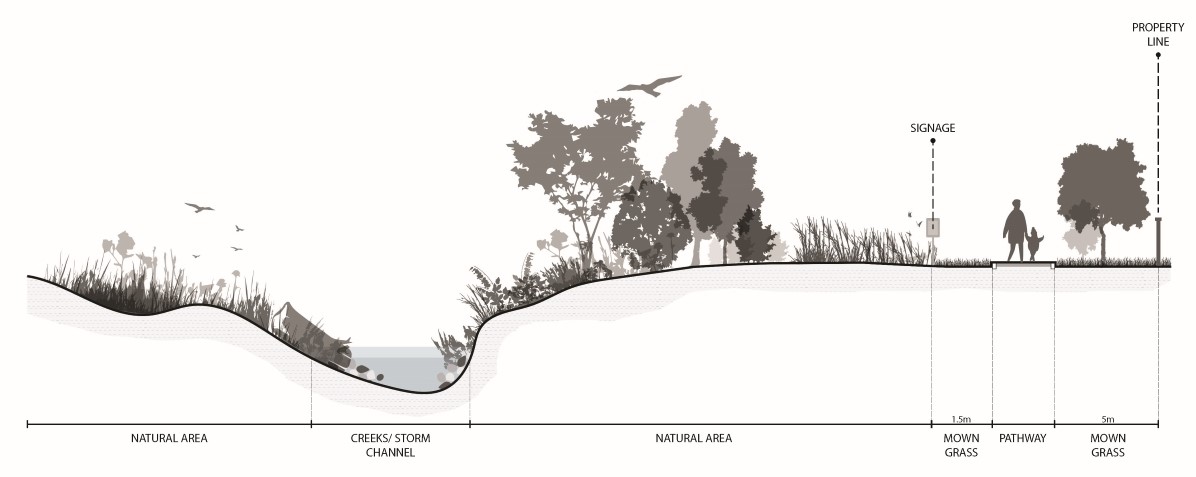The Parks Master Plan (2024) directs the City to increase the percentage of Regina’s parks and open spaces that are maintained as natural areas from 12 per cent (currently) to 25 per cent by the end of 2028. The City will shift the maintenance practices on the affected lands to make this change, first by reducing mowing and changing weed management practices and then later by adding new plants where required. These new natural areas will typically be located along our creeks and waterways, between the multi-use pathway and the water’s edge.

What is the role of Natural Areas?
Natural Areas in Regina have many functions. They have a utility function which supports natural drainage, protecting properties from flooding and preventing soil erosion, which in turn helps to protect our creeks and waterways from pollution. They also have an ecological function providing habitat for plants, animals, insects, and microbes which are important to our local ecosystem. They serve a climate function, storing carbon from the atmosphere in plant roots and stems, and allowing rainwater infiltration to recharge our groundwater aquifers. Finally, natural areas have an important recreation function, creating diverse opportunities for walking, running, cycling, skiing and snowshoeing while also supporting unprogrammed outdoor activities like bird and animal watching and exploration.
What kinds of natural areas does the City maintain?
The natural areas that the City maintains fall into four general categories, each of which is home to a unique variety of plants, animals and insects.
Grassland Areas
Typically, a mix of native and non-native grasses, wildflowers and shrubs. These areas tend to be located along Regina’s creeks and waterways above the top of the bank where the land is dryer.
Wetland / Marsh Areas
Typically, a mix of native and non-native grasses, reeds, cattails and other emergent (growing in the water) plants, along with some wildflowers, trees and shrubs. These areas are located along Regina’s creeks and waterways between the top of the bank and the water’s edge, where the land is wetter.
Woodlot / Forested Areas
Typically, a mix of trees and shrubs with a groundcover of native and non-native grasses and wildflowers. They can be located either right beside creeks and waterways or up the bank away from the water.
Savannah Areas
Typically, a mix of native and non-native grasses, wildflowers and trees with few or no shrubs. These areas tend to be located along Regina’s creeks and waterways above the top of the bank where the land is dryer, but where trees have been planted or grow naturally within a grassland area.
Where are Regina’s natural areas currently?
- Along Wascana, Pilot Butte and Chuka Creeks
- Along the North, South and Harbour Landing Storm Channels
- In A.E. Wilson Park
- In Westhill Park
- At the McKell Wascana Conservation Area
How does the City maintain natural areas?
Grassland and Savannah Areas will be mown a maximum of once per year except in cases of extreme fire risk or in the case of severe noxious weed infestation.
- Mowing, if applicable will occur in late summer to allow grass to mature and seed itself, and to allow ground-nesting birds to fledge. This timing results in a better grass and minimizes weeds like Canadian Thistle and Foxtail.
- A mown strip (typically 5m wide) will be maintained monthly along all fence lines.
- A mown strip 1-2m wide will be maintained along the edge of all pathways on a monthly or more frequent basis to allow on-leash dogs and their owners access to shorter grass on the side of the pathway, making it easier for owners to collect pet waste.
- Spot-treating weeds with insects that eat them, string trimming or manual pulling will occur on an as-needed basis at the determination of the City.
Riparian / Marsh Areas, Woodlot / Forest Areas:
- No mowing will be undertaken in these areas except in cases of extreme fire risk or in the case of severe noxious weed infestation.
- A mown strip (typically 5m wide) will be maintained monthly along all fence lines.
- A mown strip 1-2m wide will be maintained along the edge of all pathways on a monthly or more frequent basis to allow on-leash dogs and their owners access to shorter grass on the side of the pathway, making it easier for owners to collect pet waste.
View some common questions and answers about our natural areas.
What kind of herbicide will be used to treat weeds in the natural areas?
In 2023, Council passed a motion to end the use of herbicides in City parks and open spaces.
What is Canadian Thistle?
Canadian Thistle is an invasive root-creeping perennial weed that has white or purple flowers and long narrow, crinkled leaves with spiny edges. It is managed through mowing or hand weeding to prevent seed spread.
What is Foxtail Barley?
Foxtail Barley is an invasive grassy weed that usually shows up in summer. Before these weeds sprout their foxy seed heads, they can be difficult to spot, as the leaves look similar to the rest of the grass in your lawn. Foxtail Barley weed is controlled through managed mowing or string trimming.
The long grass is a breeding ground for ticks and other pests, how is the City managing this?
The City is utilizing a mowed strip on either side of the asphalt and crusher pathways to minimize the risk of ticks and other pests transferring onto passers-by.
The long grass is a breeding ground for mosquitos, how is the City managing this?
The City continues to identify, monitor and treat standing water areas with a biological agent to prevent mosquitos.
What does the City do to manage rabbits?
Rabbits are part of the Regina ecosystem and their populations ebb and flow. Currently there isn’t a program to manage rabbit populations.
Are commercial sites required to maintain their property?
Yes. The City continues to work with businesses in the community, as well as to share educational materials that outline best practices on landscaping maintenance for homeowners and local businesses.
What can be done about vacant lot maintenance?
The City works with the owners of vacant lots to combat overgrown vegetation regardless of whether weeds or grass is present. If you have concerns about vacant property, contact the City of Regina at 306-777-7000 with the specific lot detail.
Are the pipeline companies responsible for maintaining the easements?
The City of Regina mows all pipeline easements in Harbour Landing, other corridors in the city are maintained by the pipeline companies themselves. Pipeline companies also occasionally perform routine maintenance on their infrastructure and re-seed after completion.
Why am I required to maintain my property, yet the City is allowed to let the grass grow?
The City manages its parks and open spaces using a variety of methods. Natural areas are designed to mimic a natural ecosystem, providing plants to help filter runoff to improve water quality before it reaches creeks, ponds and storm channels. Natural areas also provide important habitat for native birds and animals.
Are homeowners required to landscape their property?
Homes completed prior to January 2019 are required to ensure that their properties are well maintained and do not allow weeds or soil to spread onto neighbouring properties. Homes approved for construction after January 2019 are required to complete their front-yard landscaping in a way that prevents weeds and erosion. New homes must have front and side yards developed within two years of receiving an occupancy permit.
If a resident reports a delinquent property, a City bylaw or development officer will visit the property and make a record of any infractions. If it is deemed to be in contravention of any City Bylaws, a notice to comply will be issued to the registered property owner. Subsequent enforcement will ensue if necessary. Additionally, information is available online at Regina.ca/Yardcare, as well as on the main floor lobby of City Hall.
What can be done if residents are not maintaining their yard?
If you have concerns about property, contact the City of Regina at 306-777-7000 with specific detail.




